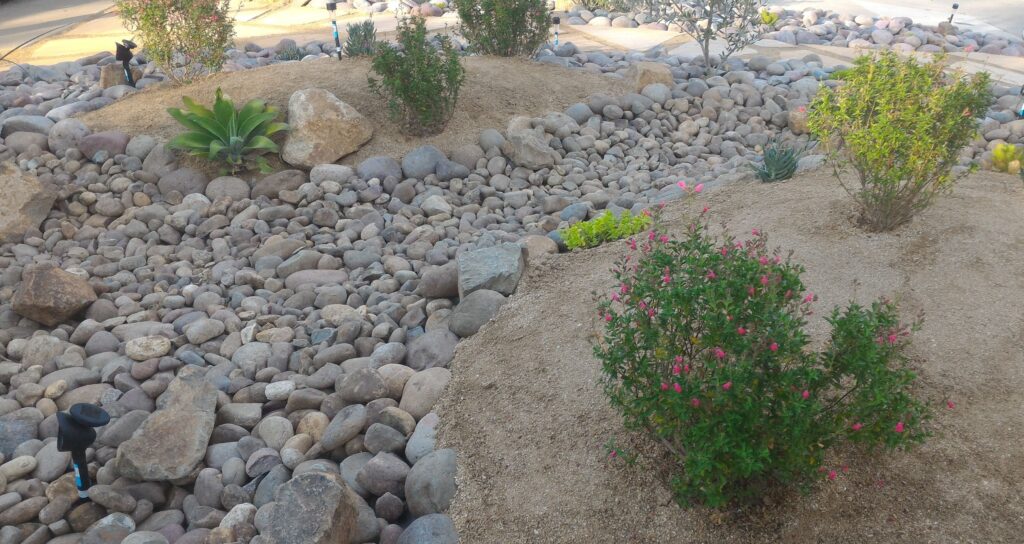Don't Overlook Your Drainage System

Spring and summer are exciting seasons for home and business owners looking to upgrade their outdoor spaces. While it may be tempting to jump straight to the fun part—florals, lighting, and hardscapes, etc.—making sure your drainage system is functioning properly should be a top priority.
Though drain management may not be high on your list of warm-weather projects, proper lawn drainage is an absolute necessity for maintaining a healthy lawn and beautiful landscape. When you neglect your drainage system, you risk a soggy lawn, foundation damage, and even mold growth. At Keith Isham Landscaping, we believe that a beautiful yard begins with smart, functional infrastructure—and that starts underground. In this blog, we’ll walk you through the signs that your drainage system may need work, the types of drainage systems available, popular drain models, and how to find the right professional for the job.
Warning Signs Your Drainage System Needs Attention
Water is essential for a healthy lawn and landscape, but it can cause serious damage when not managed correctly. Watch out for these common signs that your property’s drainage system is failing or insufficient:
1. Persistent Standing Water
If water pools in certain areas for hours (or even days) after a rainstorm, that’s a red flag. Pooled water suffocates grass roots, attracts pests, and leads to muddy messes.
2. Soil Erosion
Washed-out mulch beds, exposed tree roots, or shifting hardscape elements (like pavers or retaining walls) indicate that runoff isn’t being properly managed.
3. Wet Basement or Crawlspace
Dampness, staining, or leaks in your basement are usually caused by water that’s not being diverted far enough from your home’s foundation.
4. Mold or Mildew Smells
Musty odors, especially near the base of your home or in shaded outdoor corners, could be signs of lingering moisture and poor drainage.
5. Mosquito Infestations
Stagnant water is the perfect breeding ground for mosquitoes. If they’re hanging around more than usual, you may have unseen puddling or trapped water.
Understanding Drainage Types: Surface vs. Subsurface
Every landscape is different, and so is every drainage system. The first step in finding an effective solution for your property is understanding the two primary types of drainage: surface and subsurface. Often, the most effective systems combine both surface and subsurface drainage to manage different sources of water.
Surface Drainage
This type of drainage system manages visible surface water, such as rain that falls on your lawn, driveway, patio, or walkway. It is designed to quickly move water across the surface toward a designated runoff point. A surface drainage system typically includes swales or graded slopes that guide the flow of water, trench drains with grates that collect runoff from hard surfaces, and catch basins or channels that direct excess water away from your property. This solution is ideal for yards with compacted clay soils, areas with limited ground absorption, or properties that often experience standing water after heavy rain.
Subsurface Drainage
A subsurface drainage system is designed to manage water that saturates the soil beneath the surface. It works by collecting and redirecting groundwater before it has a chance to pool or damage your landscaping, foundation, or hardscapes. These systems often include perforated pipes installed below ground, surrounded by gravel or filter fabric to encourage proper flow while preventing clogs. Subsurface drainage is ideal for areas with consistently soggy soil, properties with poor natural runoff, or locations where surface water appears to drain but the ground remains soft and oversaturated.
Popular Drain Models for Residential Landscapes
Not all drains are created equal. Below are some of the most commonly used drainage models in both new landscaping projects and upgrades:
1. French Drains
This classic solution features a perforated pipe wrapped in fabric and gravel, buried underground. Water seeps into the gravel and is carried away through the pipe. This drain model is best for managing wet areas in lawns, around foundations, or near retaining walls.
2. Trench Drains
These surface-level drains are long, narrow, and usually covered with a metal or plastic grate. They’re perfect for directing surface runoff across driveways, patios, or pool decks. Trench drains are ideal for areas with heavy surface runoff or level hardscaping that lacks slope.
3. Downspout Drainage
Your gutters do a great job collecting roof runoff, but if the water just spills out next to your house, it’s a problem. Downspout drains extend the gutter system underground to direct water away from your home or business, protecting basements and crawlspaces from water damage.
4. Catch Basins
Installed at low points in a yard or hardscape, catch basins collect water and debris from above-ground runoff and connect to underground piping systems. This helps redirect large volumes of water in sloped landscapes.
Other Considerations
1. Increase Soil Nutrient Levels:
Aeration: Break up compacted soil with a garden fork, hollow-tined aeration tool, or even a motorized aerator. Aeration is crucial for allowing water, nutrients, and air to penetrate deeper.
Topdressing: Add a thin layer of soil or organic material (like compost) to improve soil drainage and nutrient levels.
2. Build Necessary Structures
Create a Dry Creek Bed: A channel comprised of rocks and gravel and designed to direct water away from areas prone to flooding
Build a Rain Garden: A garden that sits below the rest of the landscape and collects rainwater runoff

Choosing the Right Drainage Professional
Installing an effective drainage system isn’t just about digging trenches. It requires an understanding of soil composition, grading, hydrology, and local conditions. Here’s what to look for in a qualified contractor:
Experience with Local Conditions
Your contractor should be familiar with the soil types, water table, and seasonal weather patterns in your region. This knowledge ensures they design a system that lasts.
Thorough Site Evaluation
Avoid contractors who give a quote without inspecting the property. A drainage expert will walk your site, assess slopes, identify problem areas, and explain your options clearly.
Custom Solutions
There’s no one-size-fits-all in drainage. Look for someone who recommends tailored solutions, not just the most common fix.
High-Quality Materials
Cheap pipe or improper backfill can lead to clogging, settling, or failure. Make sure your contractor uses durable, professional-grade products.
Warranty and Maintenance Options
A reputable company will stand behind its work and offer clear guidance on maintaining your system.
Experience You Can Count On
At Keith Isham Landscaping, we specialize in drainage solutions customized to your needs. Whether you’re battling surface runoff, a soggy lawn, or a wet basement, we can guide you to the right solution.
📞 Call Keith today to schedule your drainage assessment.
